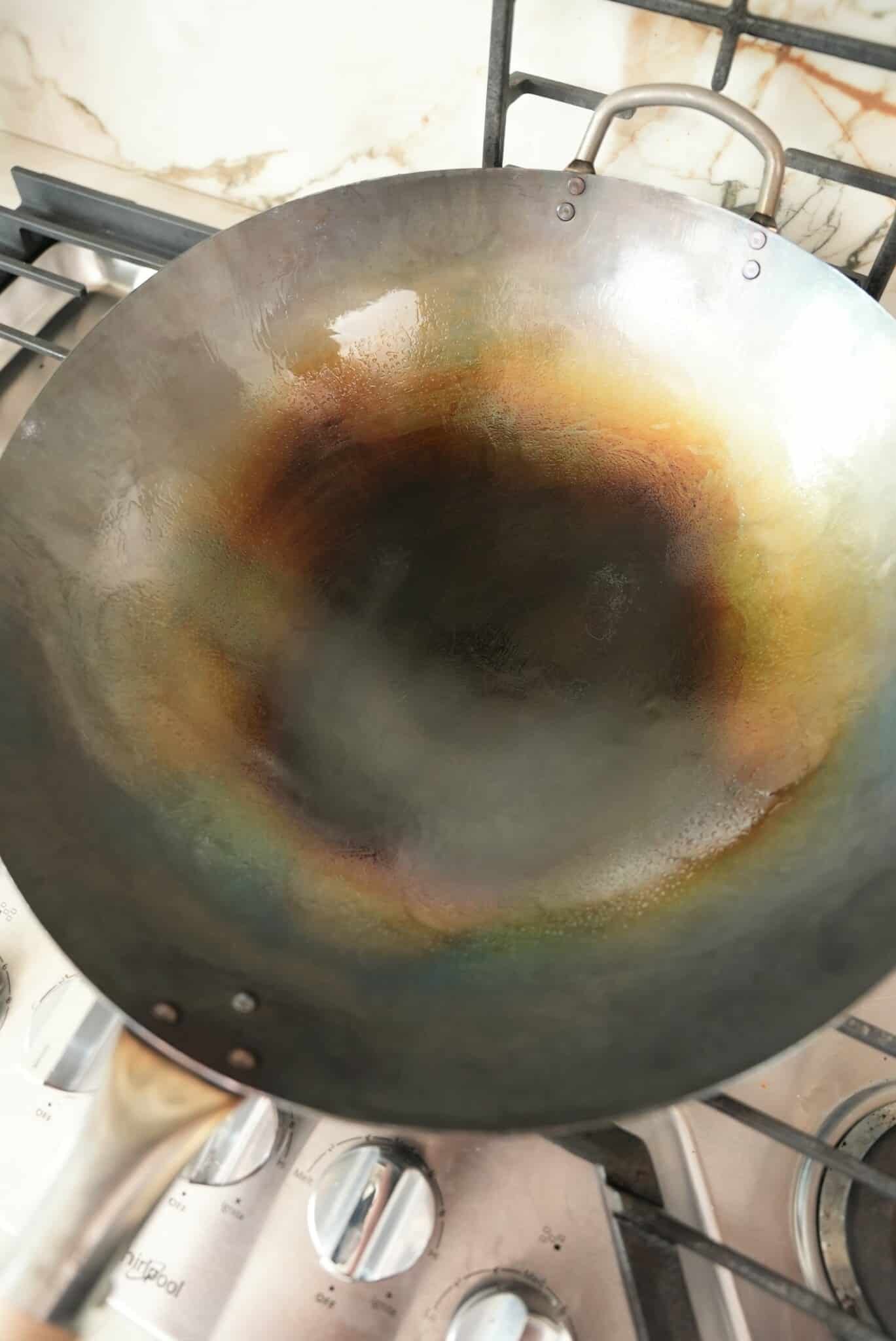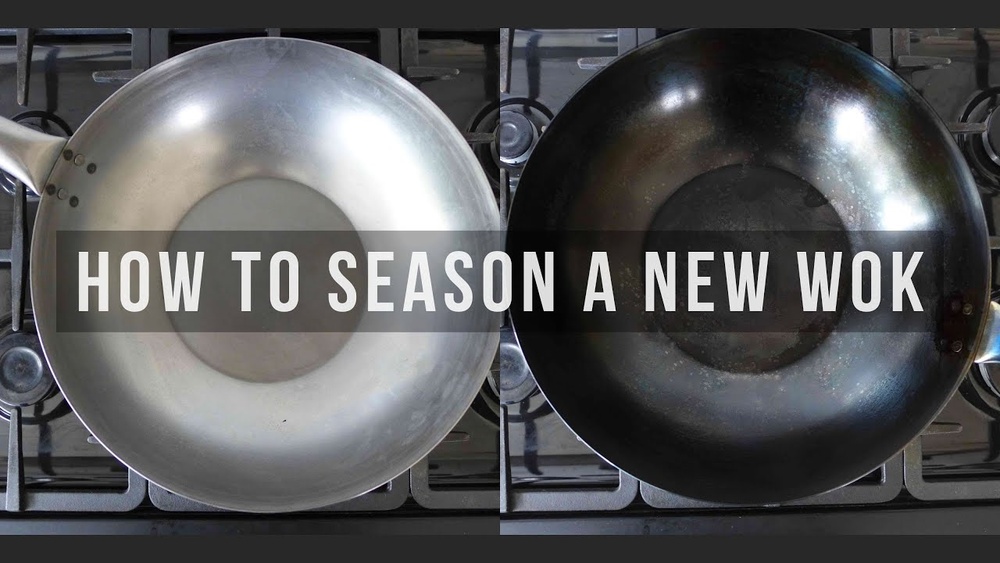If you’ve just got a carbon steel wok, you’re probably eager to start cooking delicious meals with it. But before you dive in, there’s one crucial step you can’t skip: seasoning your wok.
Seasoning not only protects your wok from rust but also creates a natural non-stick surface that makes cooking and cleaning easier. In this guide, you’ll learn exactly how to season your carbon steel wok the right way, so it performs at its best every time you use it.
Ready to unlock your wok’s full potential? Let’s get started.

Credit: www.youtube.com
Choosing The Right Carbon Steel Wok
Choosing the right carbon steel wok is important for seasoning success. The right wok fits your cooking style and kitchen space. It also affects how well the wok seasons and cooks food. Consider the type, size, and condition of the wok before buying.
Types Of Carbon Steel Woks
There are two main types of carbon steel woks. Flat-bottom woks work well on electric and induction stoves. Round-bottom woks suit gas stoves and traditional cooking. Some woks have a thick steel layer for heat retention. Others are thinner for quick heating. Pick the type that matches your stove and cooking needs.
Size And Shape Considerations
Woks come in many sizes, usually 12 to 16 inches wide. A 14-inch wok works best for most families. Small woks are easier to handle but cook less food. Large woks are good for big meals but can be heavy. The shape also matters. Deep woks hold more food and oil. Shallow woks heat up faster. Choose size and shape based on your kitchen and meals.
Pre-seasoned Vs. Raw Woks
Pre-seasoned woks have a thin oil layer to protect from rust. They save time but still need seasoning before cooking. Raw woks have no coating and require full seasoning. Raw woks may rust if not seasoned quickly. Pre-seasoned woks are good for beginners. Raw woks allow more control over seasoning but need care. Decide which option suits your patience and kitchen skills.
:max_bytes(150000):strip_icc()/cleaning-a-carbon-steel-wok-692564_final-c7556f5f8df9409a89ab77595e39e70c.jpg)
Credit: www.thespruceeats.com
Preparing Your Wok For Seasoning
Preparing your carbon steel wok for seasoning is an important first step. It sets the foundation for a non-stick surface that improves with use. Proper preparation removes any residues and protects the wok from rust. Follow simple steps to get your wok ready.
Cleaning New Wok
Start by washing the wok with warm water and mild soap. Use a soft sponge to remove dust and dirt from the factory. Avoid abrasive pads that can scratch the metal. Rinse the wok well to remove all soap. Dry it with a clean towel or paper towels.
Removing Factory Coatings
Most new woks have a protective oil layer or coating. This layer can prevent seasoning from sticking properly. To remove it, heat the wok on medium heat until it starts to smoke. Use a paper towel to wipe away the oil while it is hot. Repeat heating and wiping until the wok looks clean and dull.
Drying And Heating Basics
After cleaning, dry the wok completely to stop rust. Heat the wok over medium heat for a few minutes to evaporate any moisture. Move the wok around to heat evenly. This step prepares the metal surface for better oil absorption during seasoning.
Essential Tools And Ingredients
Seasoning a carbon steel wok needs the right tools and ingredients. These items help create a smooth, non-stick surface. They also protect the wok from rust. Preparing your wok well makes cooking easier and tastier.
Gathering the correct oils, kitchen tools, and safety gear is the first step. It saves time and avoids mistakes during seasoning. Below are the essential details to get started.
Oils Best For Seasoning
Choose oils with a high smoke point. They withstand heat without burning or smoking. Common oils include vegetable oil, canola oil, and flaxseed oil. Peanut oil is also a good choice for seasoning.
These oils create a durable, non-stick layer on the wok’s surface. Avoid olive oil or butter. Their low smoke points can cause sticky residue.
Required Kitchen Tools
Use a clean wok or pan to heat the oil. A paper towel or cloth helps spread the oil evenly. Tongs or heat-resistant gloves protect your hands from burns.
A stove or burner that reaches high heat is necessary. A spatula or brush can assist in applying oil. Keep a clean cloth nearby to wipe excess oil.
Safety Tips
Seasoning needs high heat. Work in a well-ventilated area to avoid smoke buildup. Keep a fire extinguisher nearby as a safety measure.
Wear heat-resistant gloves to protect your hands. Avoid loose clothing that could catch fire. Always monitor the wok closely during seasoning.
Step-by-step Seasoning Process
Seasoning a carbon steel wok is key to creating a natural, non-stick surface. This process protects the wok from rust and improves its cooking performance. Follow these simple steps for the best results.
Initial Heating
Start by cleaning your wok with warm water and a soft sponge. Dry it completely with a towel. Heat the wok on medium heat until it starts to change color. This removes any factory oils and opens the metal pores for seasoning.
Applying The Oil
Choose an oil with a high smoke point, such as vegetable or canola oil. Pour a small amount into the wok. Use a paper towel to spread the oil evenly across the entire surface, inside and out. Make sure the layer is thin but covers everything.
Layering And Heating Cycles
Heat the oiled wok on medium-high heat until the oil begins to smoke. This process bonds the oil to the metal, forming a protective layer. Turn off the heat and let the wok cool slightly. Repeat the oiling and heating steps 2 to 3 times for better seasoning.
Cooling And Repeating
After the final heating, allow the wok to cool completely. Wipe off any excess oil with a clean cloth. Repeat the entire seasoning process as needed until the wok develops a smooth, dark patina. This shows your wok is well seasoned and ready for cooking.
Troubleshooting Common Issues
Seasoning a carbon steel wok can sometimes come with small problems. These issues can affect your cooking and the wok’s lifespan. Knowing how to fix common problems helps keep your wok in top shape. Here are some simple solutions for usual seasoning troubles.
Sticky Or Flaky Coating
A sticky or flaky coating means the seasoning did not set well. This happens if the oil layer is too thick. Use a thin, even layer of oil each time you season. Heat the wok until the oil smokes and forms a smooth surface. Repeat the process for several layers, but do not rush.
Rust Prevention
Rust appears when moisture stays on the wok. Dry your wok completely after washing. Use low heat on the stove to remove any water. Apply a thin layer of oil to protect the metal. Store your wok in a dry place to stop rust from forming.
Uneven Seasoning
Uneven seasoning causes patches of dark and light spots. Heat the wok evenly during seasoning to avoid this. Move the wok around on the heat source for uniform warmth. Apply oil in small amounts and spread it well. Repeat heating and oiling until the surface looks smooth and even.

Credit: cjeatsrecipes.com
Maintaining Your Seasoned Wok
Maintaining your seasoned carbon steel wok is key to its long life and great cooking results. A well-kept wok stays non-stick and gains a richer flavor over time. Regular care protects the seasoning layer and keeps rust away. This section covers cleaning, re-seasoning, and storing your wok to keep it in top shape.
Cleaning After Use
Clean the wok while it is still warm. Use hot water and a soft sponge. Avoid soap, as it can remove the seasoning. Scrub gently to remove food bits. Dry the wok immediately with a towel. Heat it on the stove for a few minutes to remove all moisture.
Re-seasoning Tips
Apply a thin layer of oil after each cleaning. Use oils with high smoke points like vegetable or canola oil. Heat the wok until the oil starts to smoke lightly. This helps the oil bond to the surface. Re-season if food sticks or the surface looks dull. Repeat the oiling and heating process as needed.
Storage Recommendations
Store the wok in a dry place to avoid rust. Keep it uncovered or use a breathable cover. Avoid stacking heavy pots inside the wok. Place a paper towel inside to absorb moisture. Check the wok regularly for rust spots and clean them quickly.
Cooking Tips For Best Flavor
Seasoning a carbon steel wok is just the start. Using it right brings out the best flavors. Small habits can make your food taste better. Follow these cooking tips to keep your wok in top shape and enjoy tasty meals every time.
Heat Management
Heat controls how food cooks in your wok. Preheat the wok before adding oil or ingredients. Use medium to high heat for stir-frying. Avoid cooking on low heat; it can cause food to stick. Adjust heat based on the dish you prepare. Proper heat keeps the wok’s seasoning strong and flavors sharp.
Avoiding Soap
Never use soap to clean your seasoned wok. Soap removes the seasoning layer and can cause rust. Instead, rinse with hot water and scrub gently with a soft brush. Dry the wok immediately after washing. This care keeps the wok ready for the next cooking session. The seasoning builds up with each use, improving flavor.
Using The Wok For Different Recipes
Your wok can cook many types of dishes. Stir-fry vegetables, meats, and noodles quickly. It also works for steaming or shallow frying. Use separate cooking oils for strong spices or delicate flavors. Avoid cooking acidic foods often as they can wear down seasoning. Rotate recipes to maintain the wok’s non-stick surface and taste quality.
Frequently Asked Questions
How Long Does It Take To Season A Carbon Steel Wok?
Seasoning a carbon steel wok usually takes 20 to 30 minutes. The process involves heating oil to create a non-stick surface. Repeat the seasoning for best results. Proper seasoning protects the wok from rust and enhances cooking performance.
What Type Of Oil Is Best For Seasoning A Wok?
Use oils with high smoke points like flaxseed, grapeseed, or vegetable oil. These oils polymerize well, forming a durable non-stick coating. Avoid low smoke point oils as they can create sticky residues. Proper oil choice ensures effective seasoning and longevity.
How Often Should I Season My Carbon Steel Wok?
Season your wok after every 5 to 10 uses or when food starts sticking. Regular seasoning maintains the non-stick layer and prevents rust. Lightly oil the wok after each use to preserve seasoning. Consistent care improves cooking results and wok durability.
Can I Use Soap To Clean A Seasoned Wok?
Avoid soap to preserve the seasoning layer. Instead, rinse with hot water and scrub gently using a soft sponge or brush. Dry thoroughly and apply a thin oil layer after cleaning. This practice protects the wok’s seasoning and prevents rust.
Conclusion
Seasoning a carbon steel wok takes patience and care. Start with a clean, dry wok and heat it properly. Apply a thin layer of oil and let it smoke gently. Repeat the process several times for a strong, non-stick surface.
This helps protect your wok and improves cooking. Regular use keeps the seasoning in good shape. Soon, your wok will develop a natural, smooth coating. Enjoy cooking with your well-seasoned wok every day. Simple steps bring lasting results. Keep your wok ready for delicious meals.

